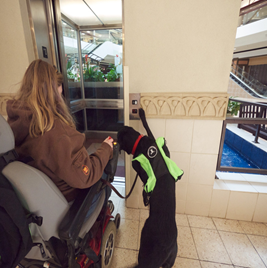SERVICE ANIMALS

Service animals assist people with disabilities in their day-to-day activities. While most people are familiar with guide dogs trained to assist people with blind or low vision, animals can be trained for a variety of tasks, including alerting a person to sounds in the home and workplace, pulling a wheelchair, picking up items, or assisting with balance.
Service animals are defined as dogs that are individually trained to do work or perform tasks for a person with a disability. Examples of such work or tasks include guiding people who are blind or low vision, alerting people who are deaf, pulling a wheelchair, alerting and protecting a person who is having a seizure, reminding a person with mental illness to take prescribed medications, calming a person with Post Traumatic Stress Disorder (PTSD) during an anxiety attack, or performing other duties. Service animals are working animals, not pets. The work or task a dog has been trained to provide must be directly related to the person’s disability. Dogs whose sole function is to provide comfort or emotional support do not qualify as service animals under the ADA.
In addition to the provisions about service dogs, the Department’s revised ADA regulations have a new, separate provision about miniature horses that have been individually trained to do work or perform tasks for people with disabilities. (Miniature horses generally range in height from 24 inches to 34 inches measured to the shoulders and generally weigh between 70 and 100 pounds.) Entities covered by the ADA must modify their policies to permit miniature horses where reasonable. The regulations set out four assessment factors to assist entities in determining whether miniature horses can be accommodated in their facility. The assessment factors are (1) whether the miniature horse is housebroken; (2) whether the miniature horse is under the owner’s control; (3) whether the facility can accommodate the miniature horse’s type, size, and weight; and (4) whether the miniature horse’s presence will not compromise legitimate safety requirements necessary for safe operation of the facility.
Under the ADA, State and local governments, businesses, and nonprofit organizations that serve the public generally must allow service animals to accompany people with disabilities in all areas of the facility where the public is normally allowed to go. For example, in a hospital it would be inappropriate to exclude a service animal from areas such as patient rooms, clinics, cafeterias, or examination rooms. However, it may be appropriate to exclude a service animal from operating rooms or burn units where the animal’s presence may compromise a sterile environment.
Under the ADA, service animals must be harnessed, leashed, or tethered, unless these devices interfere with the service animal’s work or the individual’s disability prevents using these devices. In that case, the individual must maintain control of the animal through voice, signal, or other effective controls.
Only under the following rare and unusual circumstances can a service animal be excluded from a facility:
-
The animal’s behavior poses a direct threat to the health or safety of others.
-
The animal’s presence would result in a fundamental alteration to the nature of a business or a state or local government’s program or activity.
-
The animal would pose an "undue hardship" for an employer. Such instances would include a service animal that displays vicious behavior toward visitors or co-workers or a service animal that is out of control. Even in those situations, the public facility, state or local government, or employer must give the person with a disability the opportunity to enjoy its goods, services, programs, activities, and/or equal employment opportunities without the service animal (but perhaps with some other accommodation).
A person with a service animal should relay to emergency management personnel his or her specific preferences regarding the evacuation and handling of the animal. Those preferences then need to be put in the person’s evacuation plan and shared with the appropriate building and management personnel.
People with service animals should also discuss how they can best be assisted if the service animal becomes hesitant or disoriented during the emergency situation. The procedure should be practiced so that everyone, including the service animal, is comfortable with it.
First responders should be notified of the presence of a service animal and be provided with specific information in the evacuation plan. Extra food and supplies should be kept on hand for the service animal.

User Comments/Questions
Add Comment/Question